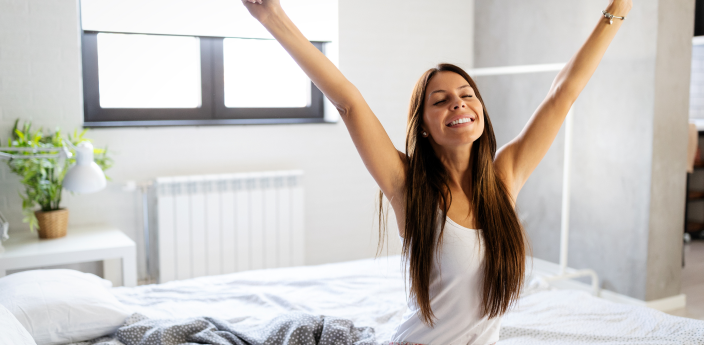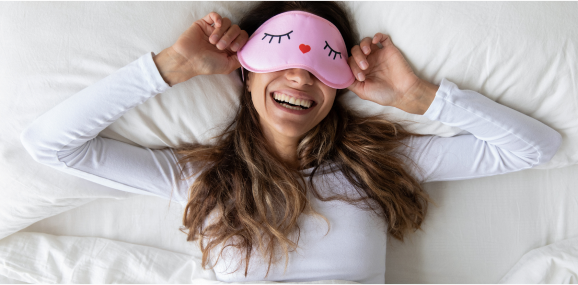Some people have trouble falling asleep, while others have trouble staying asleep. If you find yourself waking up throughout the night, the problem is usually easy to remedy.
Making a few changes to your nighttime habits and your bedroom environment can set you up for the sustained relaxation you need to fall asleep and stay asleep.
Do Over-the-Counter Sleep Aids Help?
Before you run for over-the-counter sleep aids to solve your sleep problems, there are a few things you should be aware of. Even if sleep aids aren’t habit-forming, they aren’t intended to be used long term. They might help you get a good night’s sleep, but they’re likely to leave you feeling groggy and sluggish when you wake up the next day.
Medications and supplements for sleep aren’t always benign, either. They can lead to side effects like appetite changes, digestion problems, dizziness, dry mouth, heartburn, reflux, and even addiction.
They also don’t fix the actual problem. Rather, sleep aids are more of a brute-force method. They might make you sleep through the night, but they don’t address the underlying reasons why you’re having trouble sleeping. When you stop using sleep aids, those obstacles to uninterrupted sleep will still be there.
It’s important to identify and address the problem at the root. Your body needs high-quality sleep on a consistent basis for strong physical and mental health. This means making some changes to your sleep environment to facilitate a good night’s rest.
Could I Have Insomnia or a Sleep Disorder?
If you suspect that a serious condition like insomnia, sleep apnea, chronic pain, or restless leg syndrome is making it difficult for you to fall asleep, you need to speak to your doctor as soon as possible. These issues require treatment by a health professional.
Changing your routines and habits won’t address the source of the problem. You’ll be dealing with sleep deprivation and struggling to get healthy sleep until your doctor works with you to create a treatment plan.
If you’ve had trouble falling asleep or staying asleep for several consecutive nights and you know something isn’t quite as it should be, it’s time to contact your primary care provider.
If you’re reading this for a solution at 3 a.m.? Call your doctor in the morning.
1. Start a Relaxing Bedtime Routine
Sleep shouldn’t only happen when your body succumbs to exhaustion, and the process shouldn’t start when you lie down. Rather, it should be a gradual transition that starts at the beginning of your “getting ready for bed” process.
It’s difficult to jump from cleaning up the house and taking care of your family to sleeping peacefully. Instead, try to develop good sleep hygiene and allow for a gentle transition period where you can spend time winding down before bed.
Gentle activities like yoga, reading, journaling, knitting, or drawing will give you a moment of healthy respite to calm down. Your body will have time to begin the process of preparing your body for sleep, releasing natural hormones like melatonin that inform your body that bedtime is approaching.
After you’ve completed your relaxing activity, take your time brushing your teeth, applying your skincare, and changing into your pajamas. You might also try some relaxation techniques like meditation and deep breathing.
The bottom line? If you’re looking for better sleep, try not to make yourself feel like you’re racing to get there.
2. Kick Caffeine to the Curb
Most people understand that a double shot of espresso or a caffeinated tea isn’t a wise idea at bedtime. But what many people don’t realize is just how long the effects of caffeine can last. Your after-dinner cup of coffee may still be stimulating you at bedtime.
The effects of caffeine can last up to six hours. Even if you only have a small amount of caffeine every day, the residual stimulation might be enough to keep you from falling asleep or staying asleep.
Most people will find that cutting off caffeine around lunchtime gives their body enough time to process the caffeine they’ve ingested. To help you get enough hours of sleep, it’s a good idea to set a caffeine cutoff time about six hours before you go to bed.
3. Be Firm About Your Bedtime and Wake Time
Your body really loves routine. That’s why you usually get hungry around the same time every day: Your body is expecting a meal, and it’s prepared to receive one.
If your sleep schedule is entirely unpredictable, your body won’t know when it’s supposed to get tired. If you go to bed at 9 p.m. some nights and 2 a.m. others, you’ll confuse your body so that it doesn’t have the slightest clue when it’s supposed to begin releasing sleep hormones.
Creating a sleep routine with a firm bedtime and wake time will help your body get used to falling asleep predictably. This can also help you stay asleep throughout the night for better sleep quality.
At first, it may be difficult to adjust to a firm bedtime and waketime. If you work from home or otherwise have the freedom to create your own schedule, you probably aren’t used to adhering to these kinds of rules.
Over time, though, your body will get used to the new pattern. Before you know it, you won’t need a clock to know when it’s time to go to bed and when it’s time to wake up.
4. Don’t Take Naps
There’s a time and place for naps. If you occasionally don’t get enough sleep, a 20-minute power nap can help you feel refreshed and recharged enough to face the rest of your day. But longer naps don’t have the same benefits.
A nap lasting longer than 30 minutes can leave you feeling disoriented, foggy, and more tired than you were to begin with. It may also exacerbate daytime sleepiness and disrupt your body’s natural rhythms so that you feel rested and refreshed just when it’s time to turn in for the night.
5. Keep Your Room Free From Distractions
Sometimes it isn’t you. If external factors seem to be conspiring against you, you’ll need to make some changes to achieve restful sleep.
If you’re a light sleeper, your sleep environment may be working against you. Is there loud traffic outside your house leading to 3 a.m. awakenings? Do you have noisy neighbors that stay up all night? Is there a street lamp flooding your bedroom?
Some of these issues are easier to remedy than others. If you have partying neighbors, you can file a noise complaint. If you share a landlord or a property manager with those neighbors, you can take your concerns up with the appropriate authority.
If normal ambient noises seem to rouse you from a deep sleep, a white noise machine can help to drown them out. If you don’t have a white noise machine, a standing fan will serve a similar purpose. It might also make your room feel a little less stuffy as it helps to circulate the air.
For more serious environmental noise pollution like trains and busy intersections, you can soundproof your room with padding and wear earplugs.
If it’s still too loud or impossible to block out, consider moving. Sleep is integral to your health. It’s not worth risking your health to stay in a place that’s too loud for you to sleep.
6. Sleep Alone
It’s lovely to sleep next to a partner — but less so if that partner is an active sleeper. If your partner moves around a lot, snores, or talks in their sleep, it might be best for you to sometimes sleep in separate rooms.
If the person in your bed doing all the kicking and rolling is a toddler, it may be time to transition them into sleeping independently. It’s better for both children and parents to sleep separately, since both parties need quality sleep.
7. Keep Your Phone Out of Sight
There are two very important reasons to keep your phone away from you while you sleep. The first is to prevent yourself from frequently checking the time to see how long you’ve been awake or what time you’ve woken up. Your alarm will tell you when it’s time to get out of bed, and that’s all you need. Let it go off when it goes off.
The second reason is that phones and electronic devices are inherently harmful to your sleep cycle. Electronic screens emit blue light, which makes your brain believe it’s daytime. This delays your circadian rhythm and significantly disrupts your sleep cycle.
If you have a tendency to scroll through social media in the middle of the night when you can’t get back to sleep, you’re only pushing sleep further away. Let your phone charge on the opposite side of the room, and don’t pick it up again until you get up to silence your alarm.
8. Get Up and Reset
When you wake up in the middle of the night, don’t get up. Don’t check the time. Unless you need to get a drink of water or use the bathroom, you should immediately attempt to fall back to sleep.
If your attempt doesn’t work, get up and find something low intensity to do. Go into a different room to read a book or pet your cat. Walk outside to get some fresh air and look up at the stars for a few minutes. Amble around until you begin to feel yourself getting tired again, and then lay back down.
This will help you avoid the frustration of the situation. If you start to get restless or tense about the fact that you can’t get back to sleep, you’ll only make it harder for yourself. Switching gears for a minute will allow your body to remember what it was trying to do.
Staying Comfortable All Night
Parents help their babies sleep through the night by swaddling them. Swaddles make people feel snug, comfortable, and secure.
But you don’t need to be a baby to enjoy the benefits of a soft embrace at bedtime. The Hug Sleep Pod is like a swaddle, but it’s for people of all ages (read: kids and adults alike!). You cozy up in the soft, lightweight sleep pod, and the sleep pod provides light compression from every direction.
This mimics the comfort and security of swaddling, which helps activate the parasympathetic nervous system (PSNS) and triggers the release of sleep-facilitating hormones like serotonin and dopamine.
Deep Touch Pressure Therapy, or DTPT, uses this science and gentle pressure on certain parts of the body to activate the PSNS and lull your body to sleep.
Our Sleep Pod makes use of a four-way stretch fabric to achieve DTPT sensations and signal to your body that it’s time for sleep.
Let us give you a goodnight hug with the Sleep Pod.
Sources:
Sleep Aids: Understand Over-the-Counter Options | Mayo Clinic
Common Sleep Disorders: Symptoms, Causes, and Treatment | Cleveland Clinic
Caffeine Effects on Sleep Taken 0, 3, or 6 Hours Before Going to Bed | National Library of Medicine

































500,000+ happy customers